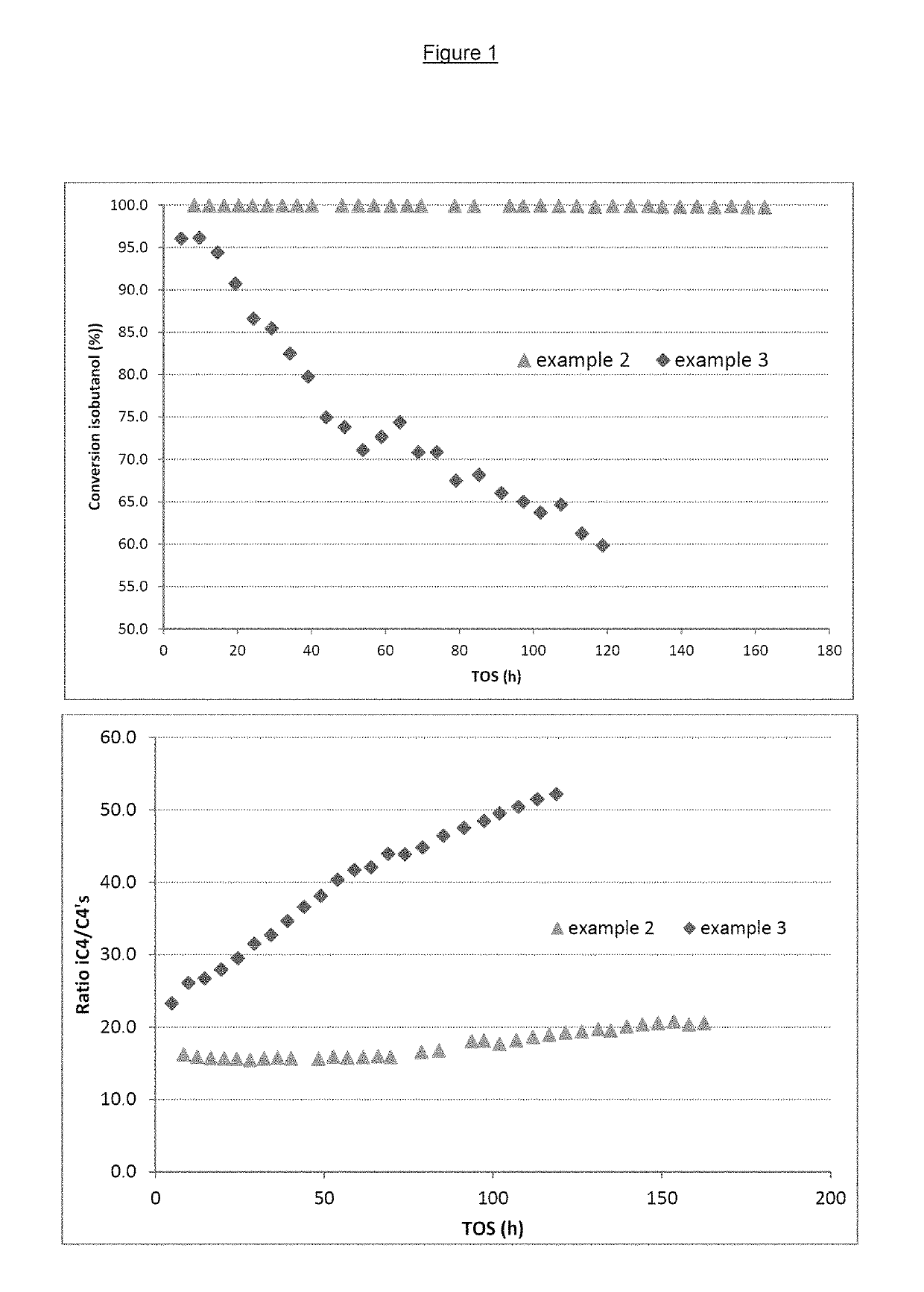Method for the isomerizing dehydration of a non-linear primary alcohol feedstock in the presence of water injection and a catalyst comprising a fer or mfs zeolite
a non-linear, catalyst technology, applied in the direction of hydrocarbon preparation catalysts, physical/chemical process catalysts, organic chemistry, etc., can solve the problem that the addition of water does not provide any improvement in the selectivity of isobutene, and achieves linear alkenes selectivity and linear alkenes selectivity. improvement, the effect of increasing the selectivity of total alkenes
- Summary
- Abstract
- Description
- Claims
- Application Information
AI Technical Summary
Benefits of technology
Problems solved by technology
Method used
Image
Examples
example 1 (
in Accordance with the Invention)
[0061]The catalyst A is prepared by mixing 70% of commercial ferrierite powder in ammonium form having an Si / Al atomic ratio of 20 and 30% of a commercial silica source, and 9% of a commercial silica source (the weight fractions are calculated relative to the total dry weight of the powders) by mixing with an aqueous solution of triethylammonium TEAOH, extrusion, drying then calcination.
[0062]The catalyst A is used in the catalytic test as described above, the feedstock flow rate is 10.5 g / h, which corresponds to a WWH of 7 h−1 for a mass of 1.5 g of catalyst loaded.
Initialn-butenes / C4 =InitialIsobutyraldehydeWater in then-butenes / total butenesInitial C4 =selectivityisobutyraldehydeselectivityfeedstockTConversiontotal butenesafter 72 hselectivityafter 72 hselectivityafter 72 h(wt %)(° C.)(%)(%)(%)(%)(%)(%)(%)Not in accordance with the invention030099.182.484.189.997.80.060.06040099.86577.088.998.70.110.41In accordance with the invention730098.582.684...
examples 2-3
Isothermal Conditions
Example 2 with 30% Water (in Accordance with the Invention)
[0067]The catalyst A is used in a catalytic test under isothermal conditions.
[0068]For the test, 200 ml of catalyst are loaded in the form of extrudates into two reactors (100 ml of catalyst per reactor). The feedstock flow rate is 770 g / h, which corresponds to a WWH of 7.0 h−1.
[0069]The feedstock is preheated before entry into the first reactor Rx1 in order to have a weighted average temperature of the catalyst bed of 350° C. Between the two reactors, the feedstock is also preheated to ensure a weighted average bed temperature of 350° C. in the second reactor.
[0070]The test is conducted with a feedstock containing 30 wt % H2O.
[0071]A complete conversion of the isobutanol and a stable performance can be observed (FIG. 1).
[0072]The ratio of isobutenes to all butenes is also stable (+4% in 160 h).
example 3
[0073]The test is conducted with a 100 wt % isobutanol feedstock. The very rapid deactivation and an increase in the ratio of isobutenes to all butenes of 30% in 120 h can be observed.
PUM
| Property | Measurement | Unit |
|---|---|---|
| pressure | aaaaa | aaaaa |
| pressure | aaaaa | aaaaa |
| temperature | aaaaa | aaaaa |
Abstract
Description
Claims
Application Information
 Login to View More
Login to View More - R&D
- Intellectual Property
- Life Sciences
- Materials
- Tech Scout
- Unparalleled Data Quality
- Higher Quality Content
- 60% Fewer Hallucinations
Browse by: Latest US Patents, China's latest patents, Technical Efficacy Thesaurus, Application Domain, Technology Topic, Popular Technical Reports.
© 2025 PatSnap. All rights reserved.Legal|Privacy policy|Modern Slavery Act Transparency Statement|Sitemap|About US| Contact US: help@patsnap.com


